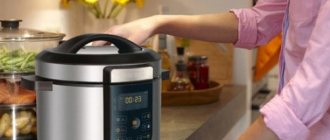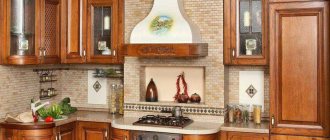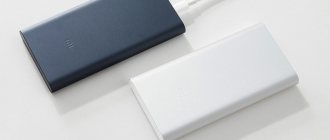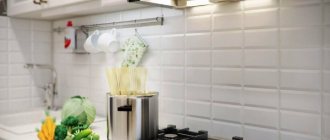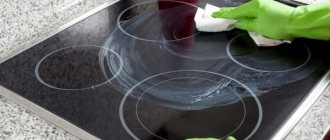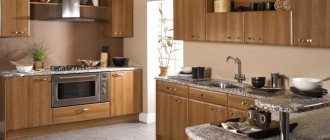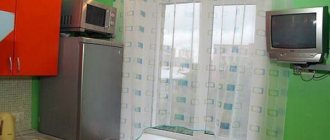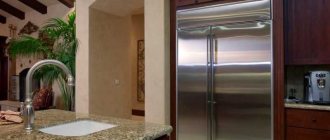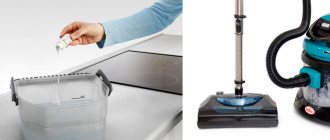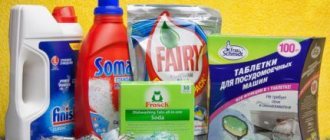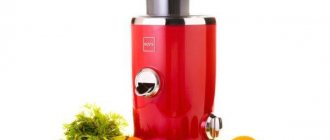The hood can be cleaned using ordinary home remedies: soda, vinegar, ammonia, laundry soap or lemon. If it has not been washed for a long time, then these methods will most likely no longer help; more radical measures and the use of household chemicals will be needed. Regular Fairy will also do, but housewives recommend in these cases special products for hoods, ovens, and cookers: Green&Clean Professional, Isesclean, AmWay, Sano Forte Plus, Topperr. As a last resort, use the Mole. A clean exhaust hood is the key to clean air in the house. Therefore, it is important to keep it in order.
Preparation
The hood should be cleaned after disassembling it into its component parts. Before doing this, you need to read the instructions for the device. Then turn off the hood from the electrical network and proceed sequentially:
- Open the case by unlocking the latches.
- Remove the filter.
- Remove the exhaust pipe. It is important to pay attention to what it is made of. Not every material can be washed. Information about this can be found in the instructions for the hood.
- Then wash each part, along with the body itself, in the bathroom, first soaking it in a solution with detergent.
Don't forget that the surface of the hood also needs to be cleaned. The washing solution is prepared in a ratio of 1:4, where water accounts for four parts, and a cleaning agent, for example Fairy, accounts for 1. A regular sponge is used for cleaning. Afterwards, all structural elements are wiped dry.
Common Mistakes
What NOT to do if you clean the hood yourself:
- Turn on the device immediately after washing if you cleaned the inside of the housing. The fan and motor must dry out.
- Wash the disposable filter. They only need to be replaced.
- Clean the plastic filter with steam or pour boiling water over it. High temperatures can deform plastic.
- Use stiff brushes, abrasive cleaners and steel wool to clean the exterior of the cabinet. A smooth surface can be scratched, especially if you rub hard.
- Use alkaline cleaners to clean aluminum filters.
- Use alcohol-containing detergents and solvents to clean the cabinet. After such cleaning, the surface may become dull.
About island hoods - description, installation, pros and cons
Where to make a socket for a hood in the kitchen: placement rules
Related Posts
Folk remedies for washing mesh and hood parts
The choice of product in this case is dictated by the degree of contamination of the hood. Folk tricks are suitable for cleaning light stains, plaque, and dirt. The best helpers: soda, vinegar, soap, citric acid, ammonia, hydrogen peroxide, silicate glue.
Soda
Common household stains can be removed using several methods. Baking soda solution is the cheapest and most harmless for both humans and machines. Good for cleaning mesh. Step-by-step instruction:
- Prepare a container that matches the size of the mesh.
- A soda solution is poured into it: half a large spoon of soda per 3 liters of water.
- Then they begin processing the mesh on each side in turn.
If the water is heavily contaminated, you can boil it. The whole procedure takes no more than half an hour.
Ammonia
If there are stains or traces of dirt, take ammonia (half a large spoon per 3.5 liters of hot water). Ammonia has a strong smell and irritates the upper respiratory tract, so it is better to wear a mask and ensure good ventilation of the apartment. This is especially true in panel and apartment buildings. The mesh must remain in the solution for at least 90 minutes. After this, it is washed with a stream of running water and dried with a towel.
Soap
The solution is prepared at the rate of half a laundry soap per bowl of hot water. Small parts of the hood can be boiled in this solution. The mesh is rubbed with the mixture and manually cleaned from dirt and grease.
Vinegar
One of the most effective home methods. It is important that the vinegar is undiluted. Then the light dirt melts before our eyes. It is worth considering that vinegar has a pungent odor and causes irritation to the nasopharynx and eyes. Excellent ventilation is needed. The processing technique is simple. A sponge soaked in the product is used to treat all elements one by one. Wait 10-15 minutes, and then wash the filter and other parts in water and dry with a napkin.
Lemon
Fruit juice works no worse than vinegar, breaking down contaminants. It is absolutely safe and can be used to treat any part of the structure. Natural juice can be successfully replaced with diluted citric acid (3 large spoons per liter of water).
Combined remedy
Recipe:
- 5 liters of water;
- half a piece of laundry soap;
- 1/2 bottle of hydrogen peroxide,
- 1/2 jar of ammonia;
- 5 tbsp. l. glue;
- 2 tbsp. l. soda;
- 2 tbsp. l. salt;
- lemon juice;
- 1/2 tbsp. l. vinegar and ethyl alcohol.
Mix all ingredients and place a wire rack into the mixture. Wait at least 3 hours and the grate will be as good as new. Since fat, when dissolved, gives off an unpleasant aroma, the entire procedure must be done with an open window and in a room with tightly closed doors.
Useful tips for the hostess
Before carrying out the procedures, remember the rules:
- do not wash the replacement filter, it needs to be changed, otherwise the device will not work well;
- do not boil plastic parts;
- do not use metal mesh or abrasive powders for cleaning;
- do not clean aluminum filters with alkali;
- ventilate the kitchen after cleaning.
Cleanliness in the kitchen is very important for any housewife. We can say that the methods described in the article are suitable not only for cleaning hoods. Vinegar, citric acid and soda are used to clean a wide variety of surfaces. To make your kitchen shine, read the rules for cleaning a gas stove and its electric counterpart, a multicooker, and a microwave. Many people do not suspect, but the dishwasher also needs regular cleaning, and our article will tell you how to do it correctly.
Household chemicals for cleaning hoods
Professional products are used for old stains. If the hood has not been treated for more than six months, home methods cannot cope with the problem. The following products are needed: Fairy, Shumanit, Green&Clean Professional, AmWay, Sano Forte Plus, Topperr, Mister Muscle, Silit Banks, Mole. They certainly have their advantages: they are narrowly targeted (they act on a specific type of pollution), require virtually no effort, and are used economically. But at the same time, these solutions can be aggressive towards metal and other materials from which the hood is made.
When using them, you need to wear gloves on your hands. You will also need sponges, rags, and a towel.
The method of processing components does not require more than 10 minutes and consists of soaking the hood parts in professionally prepared solutions. If there are no contraindications in the instructions, you can wash the grill and accessories in the dishwasher.
The mole cleaning method is considered the most radical. It can be used a maximum of a couple of times during the entire service life of the hood. It involves immersing the parts in Mole's solution (be sure to wear gloves while doing this). The reaction begins immediately. After treatment, you need to rinse the hood parts under running water for a long time. The alkali contained in the product should not remain on the components; it “eats” the metal.
How to clean the hood grille
The grate is a mesh on which more grease and other waste accumulates than on the filter, so you should approach the maintenance of this element with responsibility.
Most often, the grate is made of stainless steel, so its cleaning is carried out by boiling. So, to get rid of fat on the mesh, you should follow these steps:
- Prepare a container (that will fit at least half of the grill) with boiled water;
- Make a solution with one of the products that were described in the middle of the article;
- Leave the grid in the liquid for a certain time, which is suitable for the chosen product;
- Rinse the element under running water to remove chemicals or other caustic substances.
It is recommended to remember to use protective equipment when working with special products, solutions of soda, vinegar, alcohol and other harmful substances. Regular cleaning of the kitchen hood is the key to efficient operation of the device.
Methods for cleaning various parts of the hood
A kitchen hood has the following components: an air duct, a mesh, in some cases a filter, a motor, a fan, a case and a button panel. Washing only the body with buttons is ineffective. It is necessary to completely clean the hood at least once a quarter in order for it to serve effectively and for a long time.
Filter
There are two models for operating the hood: using a filter (preferably) and without it (in this case, the air duct can become very dirty and require complete replacement over time). If you use a filter, it should be changed as it wears out. The instructions indicate the expiration date of the cartridge.
Net
The most popular solution is baking soda and salt. With this method of cleaning, you need a large container into which you need to pour the cleaning solution and put it on the fire. The mesh is placed there for 2-3 hours. If there is no such container, then you will have to boil one side first, then the other.
Such cleaning requires time and good ventilation of the room. For better results, after boiling, you can clean the mesh with a soft bristle brush. It's even better to put it in the dishwasher. Housewives have recently preferred soaking in Coca-Cola to this method. It dissolves fat without residue and requires no effort other than rinsing.
Fan and motor
The engine is the basis of normal air exchange. You need to treat it with caution and care. And most importantly - wisely. You should not touch it more than several times a year. According to the instructions, you need to determine the location of the working elements and get them. The fan and motor are always paired. They need to be separated. Then prepare the selected solution from those listed above and soak the fan blades in it for an hour. After 60 minutes, wipe off the dissolved fat with a sponge or rag, rinse under the drain and dry well.
Don't get the engine wet! It is wiped from the outside and wiped dry. If you have the slightest doubt that it is possible to carry out such cleaning yourself, you must contact the service department. The motor and fan must be dry during assembly.
Air pipe
The air duct is responsible for draft and affects the quality of air exchange in the kitchen. Its function is especially important if there is smoking there. The exhaust shaft must be changed periodically. Modern air pipes are produced in two types: plastic of various shapes and corrugated. Plastic ones are easy to clean: take them apart, soak them in a special solution, wash them, and dry them.
It’s more difficult with corrugated ones. They must be changed once a year or treated with a steam cleaner. Only after this the air duct is washed with soapy water and dried. The steam cleaner can also be used to clean the fan, grille, and motor. The corrugation is cleaned with Mole, soaking it for half an hour in the prepared solution. Sometimes the procedure requires repetition. Then the same washing and drying.
Frame
It's decor and easy to clean. The sponge is moistened in the solution selected and prepared in advance and wiped. Then remove the residue with a damp cloth and wipe dry with a towel. If laziness has led to the accumulation of fatty deposits, a general cleansing is necessary. To do this you need:
- Turn off the gas.
- Clean the housing with Schumanite or its equivalent. A combination home remedy may be used.
- Wipe with a soft sponge. Metal abrasives are excluded; they scratch the body.
- Dry.
Buttons and inner walls
Special sprays are produced for their surfaces, but they can also be replaced with traditional solutions. The idea is to spray the buttons on the panel and wipe them dry with a clean cloth. Internal surfaces are treated with a combination of products: from grease and dirt, from odor and soot. Glass inserts must be cleaned in the same way.
Periodicity
If the model has a disposable mesh, then the latter simply needs to be replaced with a new one when it gets dirty. The recommended frequency of routine cleaning for all other types of hoods is once a month. General cleaning - quarterly. Following the recommendations will save your energy, time and money.
Corrugated pipes are widely used in households: on hoods, when building water supply and air conditioning systems, and insulating wiring. Moreover, they are not expensive, for example, prices for 25 mm corrugated pipes start at 19 rubles.
